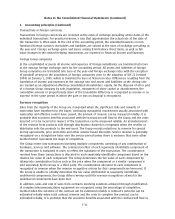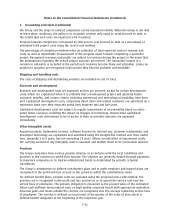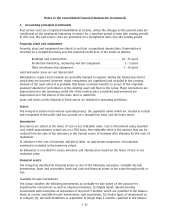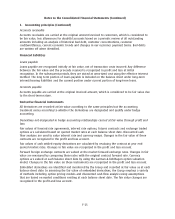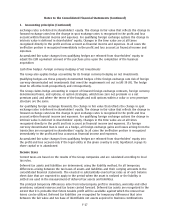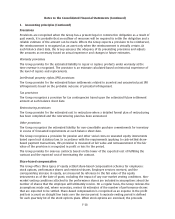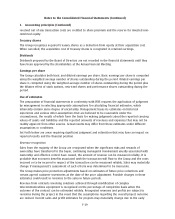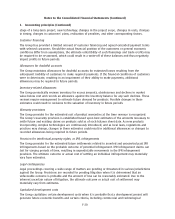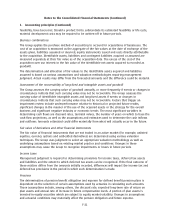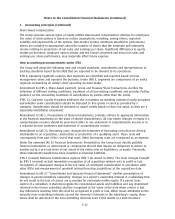Nokia 2007 Annual Report Download - page 155
Download and view the complete annual report
Please find page 155 of the 2007 Nokia annual report below. You can navigate through the pages in the report by either clicking on the pages listed below, or by using the keyword search tool below to find specific information within the annual report.1. Accounting principles (Continued)
the Group and the stage of contract completion can be measured reliably. When the Group is not able
to meet those conditions, the policy is to recognize revenue only equal to costs incurred to date, to
the extent that such costs are expected to be recovered.
Progress towards completion is measured by reference to cost incurred to date as a percentage of
estimated total project costs using the costtocost method.
The percentage of completion method relies on estimates of total expected contract revenue and
costs, as well as dependable measurement of the progress made towards completing a particular
project. Recognized revenues and profits are subject to revisions during the project in the event that
the assumptions regarding the overall project outcome are revised. The cumulative impact of a
revision in estimates is recorded in the period such revisions become likely and estimable. Losses on
projects in progress are recognized in the period they become probable and estimable.
Shipping and handling costs
The costs of shipping and distributing products are included in cost of sales.
Research and development
Research and development costs are expensed as they are incurred, except for certain development
costs, which are capitalized when it is probable that a development project will generate future
economic benefits, and certain criteria, including commercial and technological feasibility, have been
met. Capitalized development costs, comprising direct labor and related overhead, are amortized on a
systematic basis over their expected useful lives between two and five years.
Capitalized development costs are subject to regular assessments of recoverability based on antici
pated future revenues, including the impact of changes in technology. Unamortized capitalized
development costs determined to be in excess of their recoverable amounts are expensed
immediately.
Other intangible assets
Acquired patents, trademarks, licenses, software licenses for internal use, customer relationships and
developed technology are capitalized and amortized using the straightline method over their useful
lives, generally 3 to 6 years, but not exceeding 20 years. Where an indication of impairment exists,
the carrying amount of any intangible asset is assessed and written down to its recoverable amount.
Pensions
The Group companies have various pension schemes in accordance with the local conditions and
practices in the countries in which they operate. The schemes are generally funded through payments
to insurance companies or to trusteeadministered funds as determined by periodic actuarial
calculations.
The Group’s contributions to defined contribution plans and to multiemployer and insured plans are
recognized in the profit and loss account in the period to which the contributions relate.
For defined benefit plans, pension costs are assessed using the projected unit credit method: The
pension cost is recognized in the profit and loss account so as to spread the service cost over the
service lives of employees. The pension obligation is measured as the present value of the estimated
future cash outflows using interest rates on high quality corporate bonds with appropriate maturities.
Actuarial gains and losses outside the corridor are recognized over the average remaining service lives
of employees. The corridor is defined as ten percent of the greater of the value of plan assets or
defined benefit obligation at the beginning of the respective year.
F12
Notes to the Consolidated Financial Statements (Continued)











